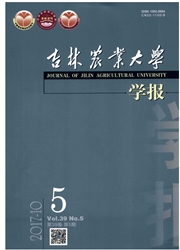

 中文摘要:
中文摘要:
通过室内模拟试验研究了玉米秸秆分解期间土壤有机质及其各组分对CO2浓度升高的响应。研究结果表明:随着培养时间的延长,土壤有机碳、水溶性有机碳、胡敏素逐渐减少,可提取腐殖物质先增加后下降,可提取腐殖物质中胡敏酸(HA)的相对比例(PQ)则在玉米秸秆分解初期表现为先减少后增加、最后趋于稳定,表明富里酸(FA)和HA经历了一段相互转化的过程后达到了动态平衡。土壤微生物量碳随着CO2浓度升高而减少,高浓度CO2处理抑制土壤微生物的活动,降低了土壤有机碳的分解速度,有利于水溶性有机碳的积累;CO2浓度升高使PQ下降,不利于HA的形成。通过相关分析,表明不同处理的土壤有机碳与土壤微生物量碳、可提取腐殖物质与土壤微生物量碳、土壤有机碳与FA间均呈显著正相关,在正常大气培养条件下,土壤微生物量碳与水溶性有机碳呈显著正相关(r=0.649,P〈0.05)。
 英文摘要:
英文摘要:
Responses of soil organic matter and its fractions to elevated carbon dioxide were studied during corn stalk decomposition by laboratory incubation experiment. The results showed that soil organic carbon (SOC), water-soluble organic carbon (WSOC) and humin (HM) decreased gradually. Extracted humic substances (HE) presented an increasing trend at first and then decreased. Relative proportion of humic acid in HE decreased at first and then increased during the initial stage of corn stalk decomposition, which indicated that the formed rate of fulvic acid (FA) was faster than HA. Then PQ dropped gradually and reached stabilization, which indicated that FA and HA transformed into each other for some time and then reached balance. Soil microbial biomass carbon (SMBC) decreased with the elevation of carbon dioxide concentration, which indicated that elevated carbon dioxide concentration restrained the activity of soil microorganism. Decomposed rate of SOC decreased and WSOC was accumulated for high carbon dioxide treatment. Elevated carbon dioxide concentration was not in favor of formation of HA. The correlation between SOC and SMBC was significantly positive and that between HE and SMBC, HE and FA was significantly positive for different treatments. The correlation between SMBC and WSOC was significantly positive at 5 % level ( r = 0. 649 ) for carbon dioxide treatment of 0. 03 %.
 同期刊论文项目
同期刊论文项目
 同项目期刊论文
同项目期刊论文
 期刊信息
期刊信息
